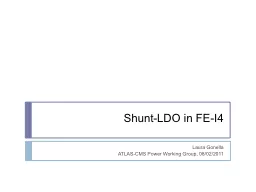PPT-Shunt-LDO in FE- I4 Laura Gonella
Author : leusemij | Published Date : 2020-06-15
ATLASCMS Power Working Group 08022011 ShuntLDO reminder Combination of a LDO and a shunt transistor Shunt regulation circuitry const I load LDO regulation loop
Presentation Embed Code
Download Presentation
Download Presentation The PPT/PDF document "Shunt-LDO in FE- I4 Laura Gonella" is the property of its rightful owner. Permission is granted to download and print the materials on this website for personal, non-commercial use only, and to display it on your personal computer provided you do not modify the materials and that you retain all copyright notices contained in the materials. By downloading content from our website, you accept the terms of this agreement.
Shunt-LDO in FE- I4 Laura Gonella: Transcript
Download Rules Of Document
"Shunt-LDO in FE- I4 Laura Gonella"The content belongs to its owner. You may download and print it for personal use, without modification, and keep all copyright notices. By downloading, you agree to these terms.
Related Documents













